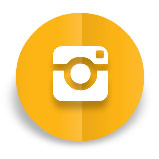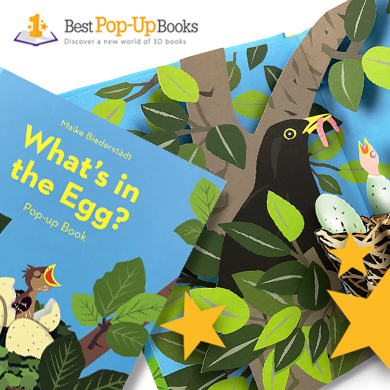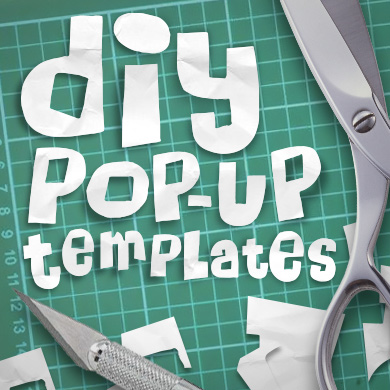
Maike Biederstaedt is a German freelance pop-up designer who lives and works in Berlin. She’s an illustrator and a very talented paper engineer. She creates the most wonderful books, greeting cards and advertising materials and recently won the coveted Louie Award (an American greeting card industry award) with her MoMA Snowflake pop-up card. She also teaches a pop-up class at AID Berlin and organizes pop-up workshops. Creatures of the Deep is her first commercial pop-up book publication and what a great introduction that is to the world of pop-ups! We’ve asked Maike Biedersteadt about her work as a paper engineer and the Creatures of the Deep pop-up book.
We have also made a review about the Creatures of the Deep pop-up book. Continue to the review…
Interview Maike Biederstaedt
BPUB – How did your passion for paper and pop-ups started?
MB – I felt the need to find something that could become my creative passion like forever. It was after studying fine arts that I came upon a pop-up book called „The Dwindling Party“ by Edward Gorey and paper engineer Ib Penick. The book and its pop-ups really excited me, although being from 1982 the pop-ups weren’t as complex as they can be today. Weeks later I had a pop-up book idea and found myself in the middle of creating my first own project Everything started from there.
BPUB – You teach about pop-up’s in Berlin. Sounds like a great study! Can you tell more about your classes and teaching methods?
MB – Yes, it happens that I am teaching a pop-up class at AID Berlin (Academy for Illustration and Design) where students have a 3d focus in their 4th semester. In 8 lectures each student realizes an own pop-up project. We start with inspirations, just browsing lots of different types of pop-up books, talking and showing pictures and videos about the history and different usages of pop-ups (like for books, cards, music videos, stage sets etc.). This is a lot of fun. With a given project theme students then develop a concept for their own pop-up. This is a super interesting process and always there are some great and fun ideas. I teach a variety of techniques along the way which can be combined for more complex structures. Students learn also about die cut drawing. During the students´ pop-up-project creation, I am helping each student to complete their project. Finally we have lots of great pop-ups which are shown off in a big round of presentations and all projects are exhibited in the semester exhibit at AID Berlin.
BPUB – How did you came up with the idea to create a pop-up book from Ernst Haeckel illustrations?
MB – It was the Publisher´s Editor in Chief who suggested a few themes that could work for them as a pop-up book. When they mentioned Ernst Haeckel I was intrigued about creating pop-ups from his beautiful drawings. This was something that really excited us both. But that is not all you need to get such a project started. All the Prestel team and sales people must believe in this book too. So we created a first spread to get a final approval.
“I worked with delicate paper cutting and paper layers to create a dimensional and filigree feeling those creatures have, the jellyfish tentacles for example.”
BPUB – Can you tell us about the techniques you’ve used engineering Creatures of the Deep?
MB – I wanted to capture the movements of the real creatures. For the octopus for example I used v-folds and put them in different directions to get that disconnected or independent sort of movement octopus arms make. Also I worked with delicate paper cutting and paper layers to create a dimensional and filigree feeling those creatures have, the jellyfish tentacles for example.
I also love tipped in paper sections, meaning you avoid to glue. This helps a lot to reduce resistance in the material. I used that with that amazing radiolaria (which is a tiny creature in plankton) to create its round form with lots of tips sticking out in every possible direction.
When working on the basic of a 2-d illustration often the result can be very flat. So it was a challenge and my intention to create real 3d. Sometimes it helped that on a plate, more then one view of an object was depicted like for the ascidian. This helped to create the actual pop-up but also to make sure there would be enough illustration material for the repro who did the digital picture-retouching to put on the 3d form.
BPUB – Ernst Haeckel has created dozens of beautiful illustrations. Was it hard to make a selection of his work?
MB – This is a really good question. We discussed some well known creatures that should go in the pop-up book in the beginning. And then I watched at all the plates in this huge book Art forms in Nature to suggest plates, that I thought are gorgeous and also suitable for creating a pop-up from. The Editor had a list, too. We set up a phone call and discussed a selection. The list was in the beginning a bit bigger and then became the real list in a second selection.
BPUB – Creatures of the Deep is both sience and art and a great introduction of Ernst Haeckel work to younger students. Is it right to say that this is also an educational book?
MB – I wasn´t sure myself, but found it in the educational categorie (and others) at my publishers website. There is very little text in the book and none at all on the spreads with the pop-ups, so that they can be watched in their beauty undisturbed. So I would say you can get yourself informed with the help of the book, but it isn´t packed with a lot of informations. What the book does is showing the beautiful illustrations in a three dimensional form and giving an impression of the creatures movement, which for me is an added magic moment.
BPUB – Can we expect more pop-up books in the future? Maybe with your own artwork? We would love to see that!
MB – Yes, absolutely. There is potential for a follow up project and it is always an option to implement an own idea too. Beauty in nature is something that currently really intrigues me, so for example a pop-up book about the 4 seasons could be something magical.
But also pop-up cards like my best selling Shimmering Snowflake at the MoMA Holiday Cards collection have huge potential. I encourage you to check out that award winning design and see what comes next.
BPUB – Thank you for your time Maike and welcome to our list of favorite paper engineers!
MB – Many thanks for the interview, for sharing this book and for your incredible bestpopupbooks.com.

















